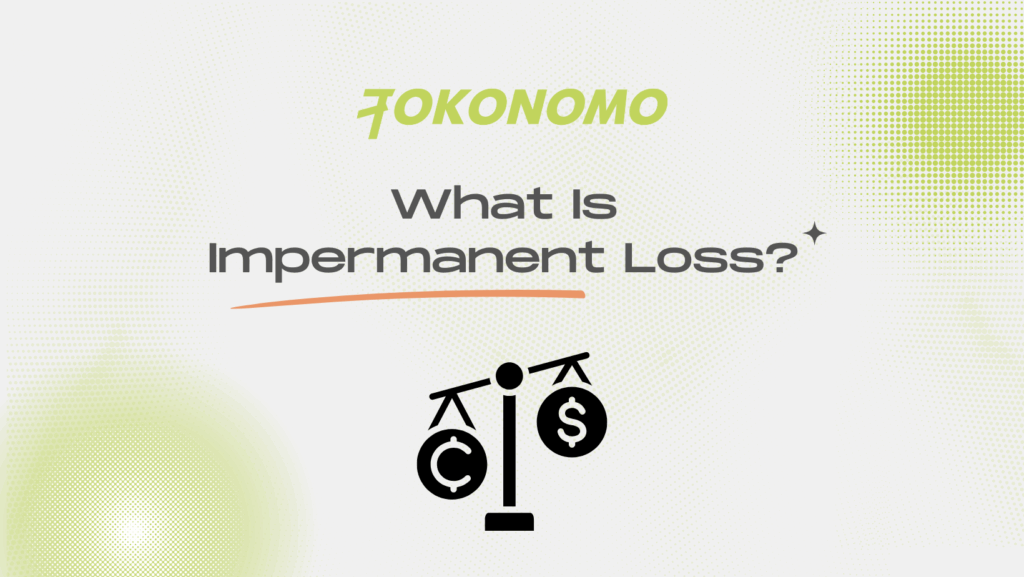Introduction
Decentralized Finance (DeFi) has revolutionized how we interact with money, offering unparalleled opportunities to earn passive income through mechanisms like liquidity pools. But here’s the catch: while providing liquidity to platforms like Uniswap or SushiSwap can yield handsome rewards, there’s a hidden risk lurking beneath the surface—impermanent loss. If you’re dipping your toes into DeFi liquidity pools, understanding this phenomenon is non-negotiable. So, what exactly is impermanent loss, and how can you protect your funds in liquidity pools? In this deep dive, we’ll break down its mechanics in DeFi, explore real-world scenarios, and share actionable strategies to help you safeguard your crypto investments.
What Is Impermanent Loss?
At its core, impermanent loss is a temporary drop in value that liquidity providers (LPs) experience when the price of assets in a pool diverges from their initial deposit ratio. Unlike a permanent loss—such as one caused by a rug pull or hack—this type of loss can theoretically reverse if asset prices return to their original levels. However, if you withdraw your funds during a price divergence, that loss becomes very real.


In DeFi liquidity pools, automated market makers (AMMs) utilize a constant product formula (such as x*y = k) to maintain a balance between the values of two paired assets. When you deposit tokens into a pool, you’re enabling trades, earning fees in return. But if the price of one token skyrockets or plummets compared to the other, the pool rebalances, and your holdings adjust—often leaving you with less value than if you’d held the tokens outside the pool. This is the essence of impermanent loss in crypto.
How Impermanent Loss Happens
Let’s get into the nitty-gritty of how impermanent loss plays out in liquidity pools in DeFi. Imagine you’ve deposited equal values of Token A and Token B into a pool. Initially, everything’s peachy—the pool maintains a 50:50 ratio by value. But here’s where things get tricky: AMMs don’t care about external market prices; they follow their internal formula. If Token A’s price doubles on the open market, arbitrageurs swoop in, buying A and selling B until the pool’s ratio reflects the new price. As a result, you end up with fewer units of Token A (now more valuable) and more of Token B (less valuable). The total value of your position in the pool is often less than if you’d just held both tokens in your wallet.
This discrepancy is impermanent loss explained in action. According to our analysis, this phenomenon is one of the biggest hurdles for novice LPs, as it can erode gains even when trading fees are factored in.
Real-Life Example of Impermanent Loss
Let’s paint a picture with numbers to hammer home the concept of impermanent loss in crypto. Suppose you deposit $1,000 worth of ETH and $1,000 worth of USDT into a Uniswap pool—totaling $2,000. At the time of deposit, 1 ETH = $1,000, so you have 1 ETH and 1,000 USDT. Fast forward a week, and ETH’s price surges to $2,000. Outside the pool, your 1 ETH would now be worth $2,000, and your USDT remains $1,000—totaling $3,000.
But in the pool, due to rebalancing, you might now hold 0.707 ETH (worth $1,414) and 1,414 USDT. Your total pool value? About $2,828. That’s a decrease of $172 compared to just holding—a classic example of this risk in DeFi. If you withdraw now, that loss locks in. If ETH’s price drops back to $1,000, the loss could disappear, but timing is everything.
Factors That Affect Impermanent Loss
Not all DeFi liquidity pools are created equal when it comes to impermanent loss. Several factors influence its severity, and understanding them can guide your decisions as an LP. Let’s break them down:
- Price Volatility: The more volatile the paired assets, the higher the risk of impermanent loss in crypto. Pairing two wildly fluctuating tokens (like two altcoins) often results in greater divergence than pairing a volatile token with a stablecoin.
- Pool Size: Larger pools with deeper liquidity tend to experience less drastic rebalancing, minimizing loss. Data from DeFiLlama shows that pools with over $100 million in total value locked (TVL) often have more stable ratios (as of September 2025).
- Trading Volume: High trading activity generates more fees, which can offset impermanent loss in DeFi. Pools with low volume leave you more exposed.
- Asset Correlation: If the two tokens in a pair move in tandem (high correlation), the risk of loss decreases. Pairing unrelated or inversely correlated assets amplifies the risk.
Strategies to Minimize Impermanent Loss
Now that we’ve dissected the problem, let’s talk solutions. While you can’t eliminate impermanent loss, these strategies can help protect your funds in liquidity pools.
1. Choose Stablecoin Pairs
One of the safest bets is to provide liquidity to pools with stablecoins (e.g., USDT/USDC). Since their prices are pegged to fiat, the risk of price divergence—and thus impermanent loss in DeFi—is minimal. Sure, the yields might be lower, but so is the headache.
2. Opt for Correlated Assets
Pairing assets that tend to move together, like ETH and WBTC, reduces the likelihood of drastic rebalancing. Their price correlation can act as a buffer against impermanent loss in crypto.
3. Use Concentrated Liquidity Pools
Platforms like Uniswap V3 allow LPs to set custom price ranges for their liquidity. By concentrating your funds within a narrow range, you can reduce exposure to extreme price swings and better manage liquidity pools in DeFi. A study by Messari noted that concentrated liquidity could cut impermanent loss by up to 50% in certain scenarios (data from 2023).
4. Monitor Trading Fees vs. Loss
High trading volumes can generate fees that outpace impermanent loss. Before joining a pool, analyze its historical fee yield versus potential loss using tools like DeFiLlama or Dune Analytics. If fees consistently cover losses, it might be worth the risk.
5. Hedge Your Position
Advanced users can hedge against impermanent loss in DeFi by taking offsetting positions outside the pool. For instance, if you’re in an ETH/USDT pool, holding additional ETH in your wallet can balance out potential downside. This isn’t foolproof, but it’s a tactic worth exploring.
When Impermanent Loss Isn’t a Big Concern
Let’s flip the script for a moment. Is impermanent loss always a dealbreaker? Not necessarily. If you’re in a pool with high trading fees and low volatility, the rewards can outweigh the risks. Similarly, if you’re a long-term believer in both assets and don’t plan to withdraw soon, temporary price divergences might not faze you. Some LPs even view it as the cost of doing business in DeFi liquidity pools—a small price for passive income and supporting the ecosystem.
Moreover, if a pool offers additional incentives like governance tokens (think SUSHI or UNI rewards), these can sweeten the deal. As per DeFiLlama data, top pools on platforms like Curve Finance often yield annualized returns of 5-10% even after factoring in potential impermanent loss in crypto (as of mid-2025).
Tools and Resources
Navigating liquidity pools in DeFi doesn’t have to be a solo journey. Here are some handy tools to help you monitor and mitigate impermanent loss:
- Impermanent Loss Calculators: Tools like the one on CoinGecko let you simulate potential losses based on price changes.
- DeFiLlama: Track pool performance, TVL, and fees to choose low-risk DeFi liquidity pools.
- Metrix: This platform offers real-time tracking of your LP positions, including impermanent loss explained through clear dashboards.
Armed with these resources, you can make informed decisions and tweak your strategies to minimize impermanent loss.
Conclusion
Stepping into the world of DeFi liquidity pools is like walking a tightrope—there’s potential for great rewards, but risks like impermanent loss can throw you off balance. By understanding how it works, recognizing the factors at play, and applying smart strategies, you can protect your funds and maximize returns. Whether it’s sticking to stablecoin pairs, leveraging concentrated liquidity, or using cutting-edge tools, the power to navigate liquidity pools in DeFi is in your hands. Want to dive deeper into mastering DeFi? Check out our comprehensive guides and take your crypto game to the next level. After all, in this fast-paced space, knowledge isn’t just power—it’s profit.
FAQs (Frequently Asked Questions)
- What is impermanent loss in DeFi?
Impermanent loss occurs when the value of assets you’ve deposited in a liquidity pool changes compared to simply holding them in your wallet.
It happens when one asset’s price moves up or down relative to the other, causing the pool to rebalance.
The loss is considered impermanent because it may disappear if prices return to their original levels.
However, if you withdraw during a price divergence, the loss becomes permanent. - How is impermanent loss different from a permanent loss?
Impermanent loss – temporary, caused by price divergence within a liquidity pool, and can reverse if prices stabilize.
Permanent loss – final and irreversible, like losing funds in a rug pull, hack, or by selling at a loss.
Impermanent loss only becomes permanent once you withdraw your liquidity while prices are still unbalanced. - Can you give a simple example of impermanent loss?
Imagine you deposit:
1 ETH worth $1,000
1,000 USDT into a pool (total $2,000).
If ETH’s price rises to $2,000:
Holding would now be worth $3,000 ($2,000 ETH + $1,000 USDT).
In the pool, rebalancing might leave you with 0.707 ETH ($1,414) and 1,414 USDT, totaling $2,828.
The difference of $172 is your impermanent loss. - What causes impermanent loss to happen?
The main triggers are:
– Price volatility – bigger swings mean higher losses.
– Low asset correlation – unrelated assets create more divergence.
– Shallow liquidity pools – small pools are more sensitive to trades.
– Unbalanced trading activity – sudden surges can amplify rebalancing. - How can impermanent loss affect my profits as an LP?
Impermanent loss can eat into your earnings from trading fees and incentives.
If a pool’s fees and rewards don’t exceed the loss, you could end up with lower or even negative returns compared to just holding the tokens. - Is impermanent loss always bad?
Not necessarily.
– In high-volume pools, fees can outpace the loss.
– If you’re a long-term believer in both assets and don’t plan to withdraw soon, temporary divergences may not matter.
– Some pools offer extra rewards, like governance tokens, that help offset losses. - How can I reduce or minimize impermanent loss?
Here are five strategies:
1. Stick to stablecoin pairs – like USDT/USDC, which have minimal price divergence.
2. Choose correlated assets – such as ETH/WBTC, which often move together.
3. Use concentrated liquidity pools – like Uniswap V3- to control your price exposure.
4. Compare fees vs. potential loss – using analytics tools before investing.
5. Hedge your position – by holding extra assets outside the pool to offset risks. - What are the safest pairs to avoid impermanent loss?
– Stablecoin-to-stablecoin pools, such as USDC/USDT or DAI/USDT.
– Correlated assets, like ETH/WBTC, tend to move in similar directions.
These pairs generally have lower volatility, reducing impermanent loss risk. - Can trading fees completely offset impermanent loss?
Yes, in some cases.
If a pool has very high trading volume, the fees you earn as a liquidity provider may exceed the impermanent loss.
However, this isn’t guaranteed — always analyze historical fee data before investing. - When does impermanent loss become permanent?
It becomes permanent the moment you withdraw your funds from the pool during a period of price divergence.
If you leave your liquidity in the pool and prices later return to their original levels, the loss can disappear. - Is impermanent loss avoidable entirely?
Not completely.
It’s a built-in risk of automated market maker (AMM) liquidity pools.
However, you can minimize it through careful pool selection, stable pairs, and active monitoring. - What’s the best way for a beginner to start providing liquidity safely?
– Begin with low-risk pools, like stablecoin pairs.
– Use analytics tools to evaluate historical data before depositing.
– Start small to learn how pools behave without risking too much capital.
– Consider concentrated liquidity if you’re ready for more advanced strategies. - Why is understanding impermanent loss so important?
Because it directly impacts your profits as an LP.
Many newcomers focus only on high APYs without realizing impermanent loss can wipe out their gains.
Knowing how it works helps you make smarter decisions, protect your funds, and maximize long-term returns.











